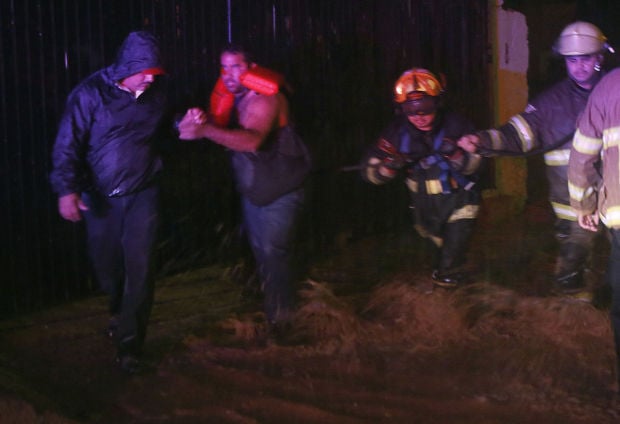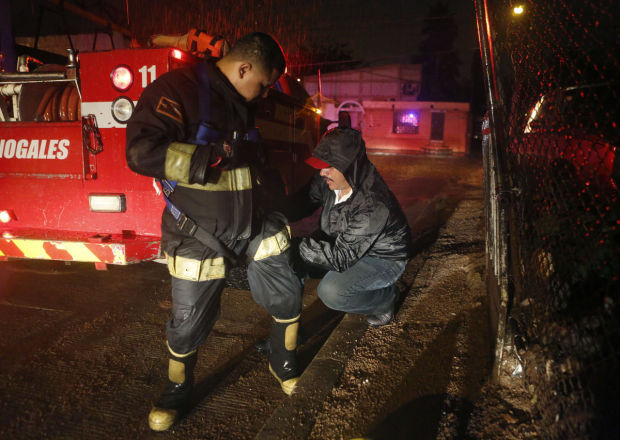NOGALES, Sonora — Anytime storm clouds loom above the hills surrounding this border town, Vicente Sanz knows it’s going to be a long night.
As head of the civil protection unit for the city of more than 220,000 people, he is in charge of coordinating with emergency personnel, including police and firefighters, the military and the mayor.
The 38-year-old father of three is a firefighter at heart. He wanted to be one since he was a kid.
alwAYS wanted to help
At 14, he spent time with the Nogales Fire Department as a visitor, hanging out and observing. Two years later, with his parents’ permission, he became a volunteer firefighter. The city’s volunteer ranks number 78 people assisting 32 paid firefighters.
Sanz, a lawyer by trade, became head of emergency management in 2012.
But on days like last Wednesday, when the skies turn gray and angry, his instincts as a first responder kick in.
The remnants of tropical depression Odile were supposed to strike starting at about 5 p.m., with rains projected throughout the night and into Thursday.
The forecast called for nearly 3 inches of rain.
For a city such as Nogales, built in the low-lying reaches of the Arroyo Los Nogales, even 1 inch of rain can be disastrous for the residents.
tracking danger
The first thing Sanz and his crew did Wednesday morning was drive to the places most prone to flooding. Of greatest concern was El Represo, an area of about 18 homes built illegally around a retention basin that was used years ago to make sure water went through the aquifers to be later used for human consumption.
When it rains, El Represo looks like a big, muddy lake that divides the neighborhood. It is impossible to cross. If it overflows, water runs downstream into the city, flooding another neighborhood, Conjunto Jardín.
Residents already know this, so by the time Sanz arrived, most had already evacuated.
Later that day, as his rounds took him once more to the area, he saw that the dirt road leading to El Represo had cracked in two.
“It’s splitting,” he said as his truck stopped before a large gap on the left side of the road.
He took pictures of the damage. Water rushed into the crack, washing exposed pipes, and a utility pole looked ready to give way.
That’s not the natural flow of the wash, he said. His crew needed to figure out what caused the shift before it all collapsed. He climbed aboard the truck and continued on to El Represo.
The area looked deserted, except for stray dogs and some children from homes farther up the hill. A woman called out to her sister-in-law who was on the other side of the running water.
“Are you going to try to cross?” she yelled.
“I think I’m going to stay here,” the other woman answered.
thin margin for error
What he knows about flooding, Sanz said, is that water will do what it wants. Unregulated settlements, or colonias, perch on the steep hillsides of the city, contributing to erosion hazards when surface runoff is high.
“Water is strong and it has a memory. If we be build a house in a place that used to be a wash, 60 years later, if it wants to, water will run through that same place,” he said. “I’ve learned that we should do things better in regards to planning. Nature is very wise.”
Throughout the day, calls kept coming over the radio and on Sanz’s two cellphones.
A meteorologist wanted a status update: “Wash roads were closed … Few reports of stalled cars.” A day-care administrator needed a letter saying they should close Thursday: “That’s outside my jurisdiction … Talk to the parents.”
A man who sold tacos on the street wanted Sanz to call his boss, saying he shouldn’t go in to work. A boy asked him to call his principal to confirm classes had been canceled.
When Sanz became a firefighter, he quickly realized that you don’t do it to be a hero.
“I’ve learned that heroes are in the cemetery,” he said. “You have to prepare yourself to be able to help others. A firefighter does this out of conviction, not to be a hero.”
One mistake, he said, and you can become a victim. There are times when he wishes he was Superman and could just tear down a wall and save the day.
finding peace in divine
In his 22 years as a firefighter, he has seen his share of tragedy.
In 2005, during a similar storm, a couple and their son were trapped inside their pickup truck after water rushed down the street. One of Sanz’s colleagues jumped into the truck bed, broke the back window, and pulled out the mother and the son.
But by the time Sanz and others tried to reach the father, the current had grown stronger. The truck sank. The man was gone.
The look of anguish and desperation the man had as the truck disappeared has never left him.
“You wonder what else you could have done. You weren’t good enough. If only you got there sooner, if only you had done this or that,” he said. “You find peace in the divine and learn to move on.”
What keeps them going is their conviction for the job and to save lives.
fighting the good fight
As the hours passed, the calls kept coming. Cars were stuck in washes. Hillsides fell away. Walls were knocked down.
In the wash by Natación, there was a 40 with 28s inside — three people trapped inside a pickup truck in one of the deadliest washes in the city.
Twenty days earlier, a family of three had been swept away in the same area. The father and his son managed to survive, but the mother fell into the water. Her body was found the next day on the Arizona side.
Sanz turned on the sirens and sped through the hilly streets. As he and his crew waited for more help to arrive, they formulated a plan.
“There’s sand covering half their wheels, the guys are on the roof, and the corner is here,” Sanz said, drawing in the air. They would reach them with a rope and get them out one by one.
Within 45 minutes they had pulled all three men to safety. One was taken to the hospital with possible hypothermia.
Sanz climbed back in his truck and waited for the next call.
To see more photos and video of Wednesday’s storm in Nogales, Sonora, visit tucson.com




